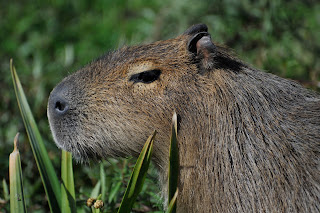
The second destination in Argentina was Estancia San Lorenzo, a working farm in the Esteros del Ibera Provincial Reserve. Esteros del Ibera are wetlands, the second biggest in the world after the Pantanal in Brazil; however tourism is not as heavy as in the Pantanal and the environment is much more unspoilt. The Pantanal's wetlands are due to the torrential rains in the area during the rainy season; Esteros del Ibera have wetlands because of the intricate system of creeks and lagoons crisscrossing the area, it is less dependent on rain compared to the Pantanal. The name 'Ibera' is composed by th Guarani words 'Y', water, and 'bera', shining. It can roughly be translated as 'shining water'. The heritage of Guarani culture is very strong in the area, reflected not only in the names of places but also in the traditional music, chamame.

Estancia San Lorenzo is set in the middle of the reserve, 80 km from the closest town. The estancia is run by Jose and Marta, a married couple. Marta prepares meals and looks after the guests whilst Jose works with animals and organises excursions for the guests. Estancia San Lorenzo was one of the most unforgettable places I have ever visited. It is different from the 'big ones', such as Rio or Iguazu. The beauty of the place lies in its tranquillity, in the silence, in the awareness of being immersed in nature. There are no busloads of tourists, there was only us. The silence at night and during the hottest part of the day was inviting one to slow down. Unlike the Northeast of Brazil, where the 'slow life' seems to be dictated by men, here the rhythm is dictated by nature.
I have found myself comfortable in Argentina; perhaps because the place is European enough without being Europe. In retrospect, it is a place I would like to call home. it may be the good food, the good wine, the magnificent scenery and glorious weather; or the musical accent that I found myself trying to imitate from the first day. Maybe what I like of Argentina is the fact that it reminds me of what Italy must have been a few decades ago; life is slower, more relaxed, a life of long lunches and afternoon siestas, where the word 'stress' was not yet invented. We did have long lunches and dinners at San Lorenzo. Being a working cattle farm, beef was always on the menu. It could be a casserole, a slow roast or my favourite pasta criolla; pasta mixed with leftover stew, pumpkin and corn. A plate which is perhaps the essence of Argentinean home-cooking; with a nod to the Italian influence (approximately 60 per cent of Argentineans have Italian background) but with a nod to the New World, as no respectable Italian would be caught dead with leftover stew in their pasta.
The highlight of our stay at San Lorenzo were the excursions organised by Jose during the day. He took us wildlife-spotting in his boat on the wetlands; we were able to see caimans, capybaras and several types of birds found nowhere else in Argentina. On the lagoons we were able to appreciate why the Guarani named this place 'shining water', as the sun creates a symphony of colours which become particularly spectacular at sunset. Driving back to the estancia we even saw an armadillo. We went in search of the elusive pampa deer, a notoriously shy animal, which we were only able to appreciate behind Nick's 400mm lens before it ran away. The nights at San Lorenzo were unforgettable. The moon was new, and the stars pierced the blackness of the sky shining like jewels. Once the generator went out, the sensation was of abandonment and ecstasis at the same time; where one truly becomes whole with nature.


No comments:
Post a Comment